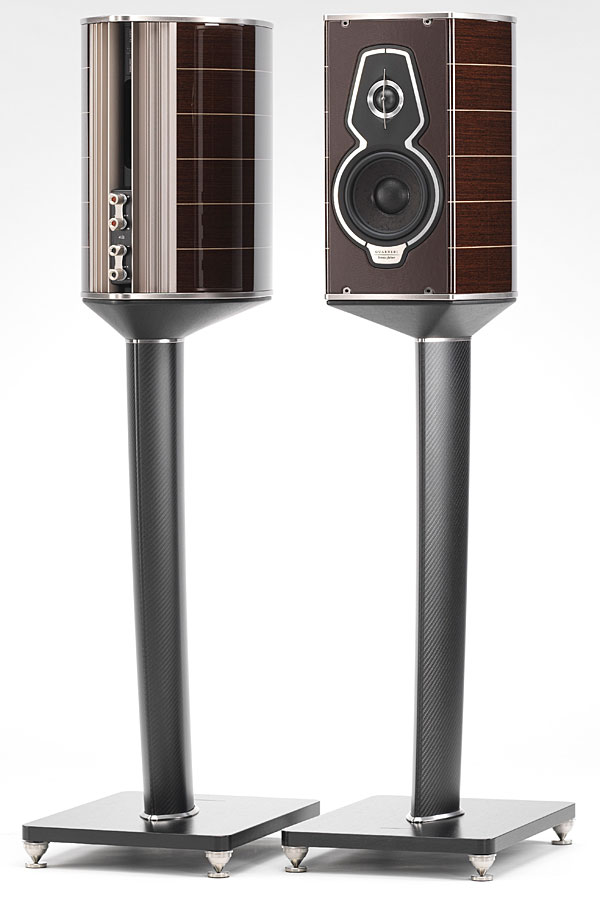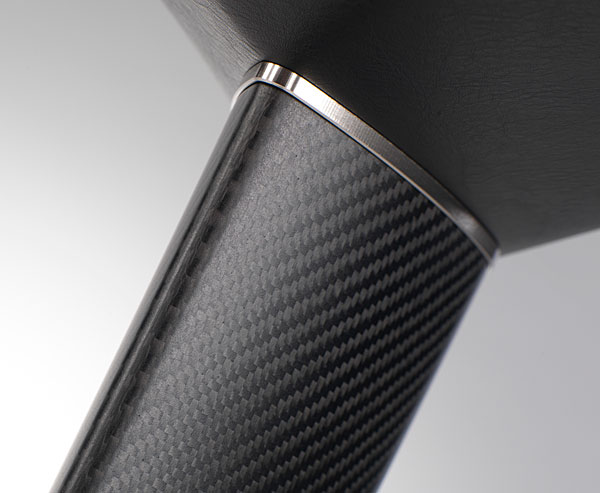Sonus Faber Guarneri Tradition Bookshelf’s (Carbon-Fibre Stands)
R148,000.00
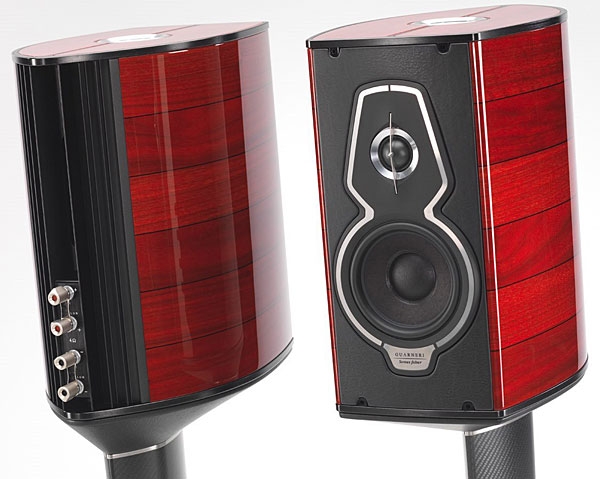
Stereophile writers have reviewed three versions of Sonus Faber’s stand-mounted, two-way loudspeaker, the Guarneri: Martin Colloms on the original Guarneri Homage, in 1994; Michael Fremer on the Memento edition, in 2007; and Art Dudley on the Evolution, in 2012. The Guarneri has always been an expensive speaker—$9400/pair with matching stands in 1995, $15,000 with stands in 2007, $20,000/pair plus $2000 for the stands in 2012—but its prices have been related to its build quality and appearance, both of which have always been superb. Now we have the Guarneri Tradition, for $15,900/pair, including stands.Sonus Faber launched their series of Homage Tradition loudspeakers at an event in February 2017, at the World of McIntosh Townhouse in Manhattan’s NoHo neighborhood. After a presentation of the technology embodied in the new speakers, we listened to the line’s three models, the floorstanding Amati and Serafino and the stand-mounted Guarneri, each in a dedicated room with a system based on Audio Research components. All three were sonically promising, but it was the smallest and least expensive that I felt would work best in my room. I asked for a pair for review.
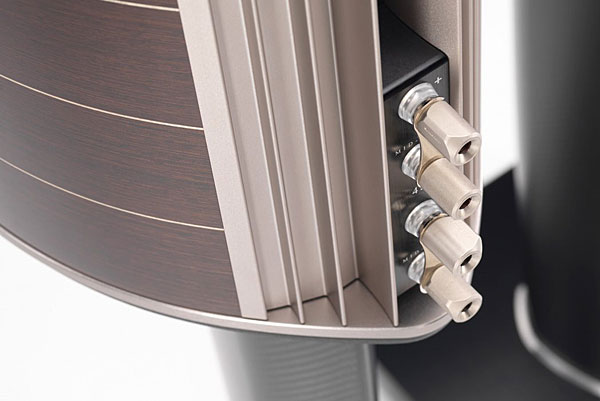
Design
Every iteration of the Guarneri since the Homage has featured an elegantly lute-shaped cross section. The form is intended to pay homage to the famed 18th-century Italian violin makers—including, of course, the Guarneri family, of whom Giuseppe “del Gesó” Guarneri (1698–1744) was the final member practicing the craft. The curved sidewalls, laminated from several thin sheets of tonewood, are veneered with wengè (a tropical hardwood often used in guitar making), with maple horizontal inlays—or walnut stained red with black inlays—and attached to an MDF frame. The top and bottom panels are of brushed, titanium-colored aluminum; the bottom is finished with black felt where it couples to the stands, and the top has wooden inlays to match the sidewalls, with a central glass circle silk-screened with an Sf logo. With a front baffle finished in leather stained brown or black, and Sonus Faber’s traditional grille of stretched vertical threads, the Guarneri Tradition is a stunningly beautiful piece of furniture.
But this is Stereophile, not Better Homes & Gardens; it behooves me to examine the technology used in this speaker. The tweeter and woofer are mounted vertically in-line within a vaguely violin-shaped accent of what looks like hard rubber, this outlined with aluminum. As in the tweeter used in the Guarneri Evolution, the Tradition’s 1.1″ (28mm) dome is of silk. But unlike the earlier speaker, a tiny damping pad is held against the center of the dome by a vertical bracket. This technology, which Sonus Faber calls Arrow Point or Damped Apex Dome (DAD), was first seen in their Lilium and Il Cremonese models, and is intended to optimize top-octave dispersion compared with ring-radiator tweeters and conventional domes. The tweeter is mounted in an acoustic-labyrinth chamber of wood.
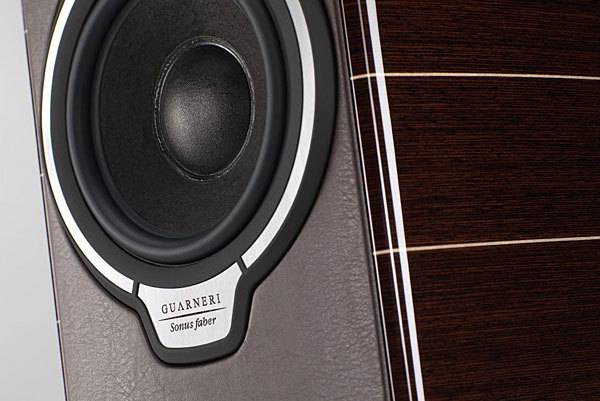
The 5.9″ (150mm) woofer features a sandwich cone and a neodymium magnet system, and is acoustically loaded with what SF calls its Stealth Ultraflex System. A vertically oriented, rectangular vent, radiused and lined with rubber at its top and bottom, is positioned between the flared vertical vanes on the aluminum rear panel. This port is 5″ deep and its internal opening is damped with black foam, to control the speed of the air flowing through the duct and reduce its turbulence.
The two drive-units are crossed over at 2.5kHz with Sonus Faber’s Paracross topology. At the World of McIntosh event, Paolo Tezzon, SF’s manager of R&D, described this topology as producing “transparency, speed, and absolute musicality.” In the diagram he showed, Paracross differs from a conventional CLC, third-order crossover in moving the second series capacitor to the other side of the drive-unit, so that that cap shares the ground connection with the shunt inductor. I don’t see why there should be any electrical difference, but the proof of the concept, of course, will be in the listening. Electrical connection is via two pairs of binding posts mounted below the reflex port.
The Guarneri Tradition stands visually match the speakers and combine a carbon-fiber central pillar, filled with some kind of damping material, with aluminum top and bottom plates. Three guide pins on the top plate fit into dimples in the speaker’s aluminum base for a secure stance. The massive bottom plate is fitted with four of Sonus Faber’s Silent Spikes, which comprise a coaxial sandwich of metal, elastomer, and metal that has been patented by SF as Zero Vibration Transmission (Z.V.T.) and was first seen in their flagship Aida speaker.
We don’t always comment on packaging, but the way these speakers and their stands were shipped deserves recognition. If someone is going to spend the price of a Toyota Corolla on an audio component, the manufacturer should ensure that every part of the experience is first-class, including the unpacking.
Sound Quality
After some experimentation, I positioned the Guarneri Traditions close to where the TAD Micro Evolution Ones had been when I listened to them for the review published elsewhere in this issue: with their woofers 74″ from the wall behind them, and, due to my room’s slight asymmetry, the left speaker’s woofer 27″ from the LPs lining the nearest wall, the right speaker’s 42″ from the books lining that wall. These positions slightly shelved down the low frequencies but gave the best transition between the mid- and upper-bass regions. The kick drum at the beginning of a live 2010 recording of Phish playing Little Feat’s “Time Loves a Hero” (16-bit/44.1kHz FLAC, no longer available) was both well defined and had sufficient, er . . . kick.
Description
Description:
Two-way, reflex-loaded, stand-mounted loudspeaker.
Drive-units: 1
.1″ (28mm) damped-apex silk-dome tweeter,
5.9″ (150mm) sandwich-cone mid/bass driver.
Crossover frequency: 2.5kHz.
Frequency range: 40Hz–35kHz.
Sensitivity: 87dB/2.83V/m.
Nominal impedance: 4 ohms.
Recommended amplification: 30–250Wpc.
Long-term maximum input voltage (IEC 268-5): 20V RMS.
Dimensions: 14.85″ (377mm) H by 9.4″ W (239mm) W by 14.75″ (375mm) D. Weight: 35.2 lbs (16kg). Dedicated stand: 29.85″ (758mm) H by 12.25″ (300mm) W by 15.35″ (390mm) D. Weight: 35.2 lbs (16kg).
Price: $15,900/pair, including dedicated carbon-fiber stands.











